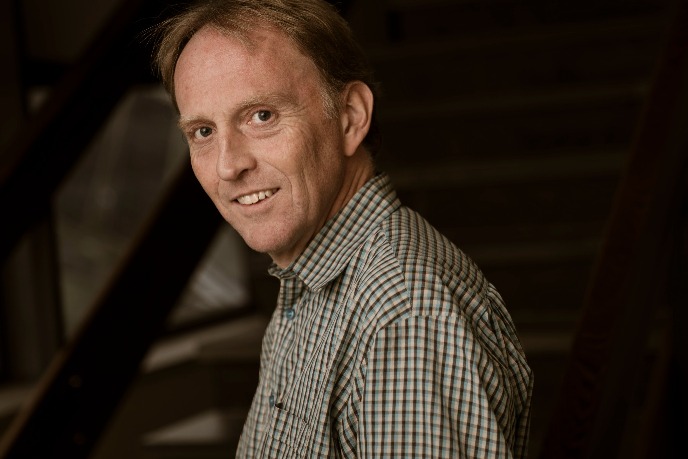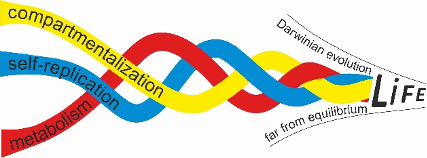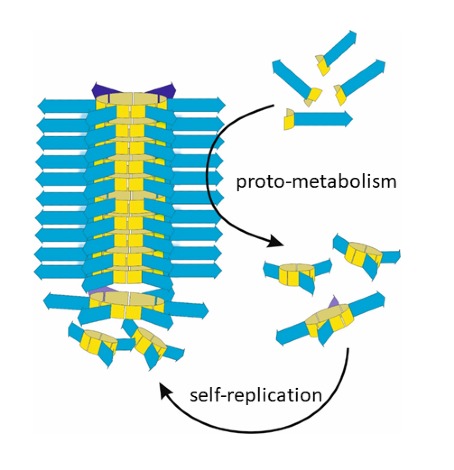Leven bouwen zonder DNA
RUG-hoogleraar systeemchemie Sijbren Otto bouwt aan synthetisch leven in het lab. Onlangs ontving hij een ERC Synergy Grant van 3,4 miljoen euro voor zijn project MINILIFE. Daarmee gaat hij samen met internationale partners verder werken aan het ultieme doel: een chemisch systeem dat tekenen van leven vertoont, maar dat uit heel andere moleculen is opgebouwd dan leven zoals we dat kennen.
FSE Science Newsroom | Charlotte Vlek
Dit interview verscheen ook in alumnimagazine Broerstraat 5
Het eerste leven op aarde moet ook ooit ontstaan zijn uit een levenloze materie. Is dat wat jullie proberen na te bootsen?

Nee, het is niet ons doel om te achterhalen hoe leven op aarde ooit kan zijn ontstaan. Er zijn allerlei andere wetenschappers die daaraan werken. Die willen dan toewerken naar het soort leven zoals wij dat nu kennen: met DNA, RNA en eiwitten als hoofdrolspelers. Wij vergeten juist uit welke moleculen het leven doorgaans is opgebouwd, en kijken alleen naar de verschillende functies die ze moeten vervullen. Die functies proberen we te laten ontstaan.
Gaat het jullie dan meer om de fundamentele vraag wat leven eigenlijk is? Daar is nog geen goede definitie voor.
Dat klopt. Gangbare definities van leven zijn vaak beschrijvend voor het leven zoals we dat om ons heen zien. Ik ben ervan overtuigd dat er een heel andere vorm mogelijk is. Als we leven op Mars ontdekken zal dat onze blik veranderen op wat leven is; zo ook wanneer we hier in het lab leven weten te maken.
Wat is er essentieel om leven te maken?
Als je kijkt naar leven zoals we dat kennen, zien we drie belangrijke functies: replicatie, stofwisseling en compartmentalisatie. Een menselijke cel heeft deze dingen in de vorm van DNA (draagt informatie en wordt gekopieerd), eiwitten (zorgen voor nieuwe bouwstenen) en het celmembraan (de buitenkant die de inhoudt afscheidt van de omgeving). Wij proberen die drie functionaliteiten na te maken, maar dan met andere moleculen als basis. Als dat vervolgens kan gaan evolueren, écht evolueren zodat er ook iets nieuws kan ontstaan dat wij er niet in gestopt hebben, dan heb je leven.

Het begon allemaal met een toevallige ontdekking, dertien jaar geleden. Wat zagen jullie toen?
Dat was in 2010, we werkten toen aan iets heel anders. In een mengsel van moleculen zagen we dat de ingrediënten zich organiseerden in ringen, die vervolgens stapeltjes gingen vormen. Dat ontstond spontaan en onverwacht. Bovendien begonnen de stapeltjes zich te repliceren: wanneer het stapeltje brak, begonnen beide delen zich weer opnieuw te stapelen. Dat is in essentie het kopiëren en doorgeven van informatie, en doet denken aan de functie die DNA in onze cellen vervult.
We waren overigens niet de eerste groep die werkte met zelf-replicerende moleculen, dat was niet nieuw. Maar vaak waren die zelf-replicerende moleculen geïnspireerd op DNA, terwijl onze replicatoren, zoals we de ringen inmiddels noemen, heel anders zijn.
Werken jullie nog steeds met dezelfde replicatoren van destijds?
Ja, wat we nu doen blijft heel dicht bij dit originele systeem. Dat blijkt veel meer te kunnen dan we destijds wisten. Dat wil zeggen: het systeem kon al veel meer dan zichzelf repliceren, alleen wij moesten nog ontdekken welke bouwstenen we aan het mengsel moesten toevoegen om die processen mogelijk te maken. En wij chemici zijn dan niet te beroerd om het systeem een handje te helpen door precies de juiste bouwstenen toe te voegen.
Wat hebben jullie inmiddels ontdekt?

Het systeem bleek niet alleen zichzelf te kopiëren maar ook af en toe te muteren. Mutatie is nuttig, want dan kan het leven zich aanpassen in veranderende omstandigheden. En we hebben inmiddels ook een vorm van stofwisseling: het systeem maakt zijn eigen nieuwe bouwstenen, wat weer bijdraagt aan de replicatie.
Wat zijn de volgende stappen?
Momenteel staan we voor twee uitdagingen: het laten ontstaan van een beschermende omhulling voor de replicatoren, een soort celmembraan dus, en van continu voortschrijdende evolutie. In beide hebben we al stappen gezet.
We zijn nu zover dat de replicatoren de bouwstenen maken die een omhulsel vormen, waar de replicatoren zelf in gaan zitten. Alleen weten we daar nog lang niet alles over: blijft het materiaal ook in die omhulsels zitten? En wat gebeurt er als de replicatoren zichzelf kopiëren, kopieert het omhulsel dan ook mee?
Om een vorm van evolutie te krijgen hebben we het systeem uit evenwicht gebracht, door steeds nieuwe bouwstenen toe te voegen en ook een deel van het mengsel weg te laten stromen. Zo introduceer je als het ware de dood, en kunnen de replicatoren alleen overleven door zichzelf snel genoeg voort te planten. We zagen toen dat de replicatoren zelfs invloed op hun omgeving begonnen uit te oefenen. Dat is nog heel rudimentair hoor. Maar door zo’n wisselwerking tussen de replicatoren en de omgeving kan het systeem zichzelf aan de haren omhoog trekken: met een klein begin kunnen er onverwachte dingen ontstaan.
En wanneer ben je op een punt dat je kunt zeggen: nu hebben we echt leven gemaakt?
Tja, het kan zijn dat dit punt er niet is. Het leven om ons heen is zo complex, dat herkennen we meteen als leven. Maar als je het van de grond af gaat opbouwen, dan kom je in een grijs gebied. Vergelijk het met kleuren: iedereen kan de kleur groen herkennen, maar als je blauw bij geel gaat mengen, dan is er geen eenduidig moment waarop je zegt: ja, nu is het groen.
Een belangrijke voorwaarde is voor mij wel dat het zelfstandig kan evolueren. Als het systeem op eigen kracht dingen gaat doen die we er niet in gestopt hebben, dan ben ik blij. En ach, uiteindelijk gaat het misschien ook niet om het eindresultaat. Als kind speelde ik ook al graag met LEGO, en als het dan af was, dan dacht ik: ja, en nu?
Bekijk ook ons overzicht van Sijbren Otto's werk:
In 2010 ontdekte RUG-hoogleraar Systeemchemie Sijbren Otto per toeval moleculen die zichzelf kopieerden. Sindsdien bouwt hij aan kunstmatig leven in het lab.
Meer nieuws
-
11 december 2025
Stormachtige planeten en een onverwachtse atmosfeer
-
09 december 2025
RUG-hoogleraar bij COP30: ‘Het is altijd drama’

